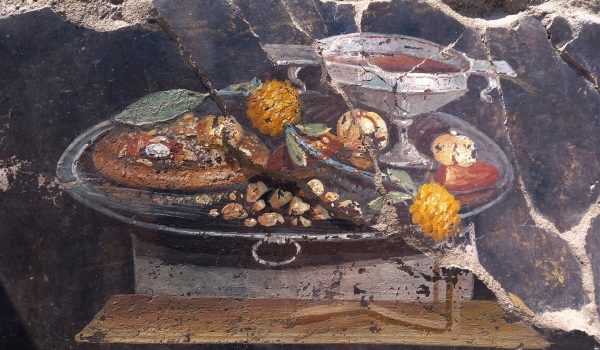Pompeii: a still life discovered by the new excavations of Regio IX
Whilst it looks like a pizza, this image from a Pompeian painting from 2000 years ago obviously can't be, since some of the most characteristic ingredients are missing, namely tomatoes and mozzarella. However, as shown by a first iconographic analysis of a still life fresco, which emerged recently as part of the new excavations in the inula 10 of the Regio IX in Pompeii, what was represented on the wall of an ancient Pompeian house could be a distant ancestor of the modern dish, elevated to the status of a World Heritage element in 2017 as the “traditional art of the Neapolitan pizza chef”.
As the archaeologists of the Archaeological Park of Pompeii explains, it is possible to suppose that next to a wine cup placed on a silver tray, there is depicted a flat focaccia that functions as a support for various fruits, (that can be identified as pomegranate, and maybe a date), with spices and perhaps with a type of pesto, (moretum in Latin) as indicated by yellow and ochre dots, possibly condiments. Moreover, on the same tray, dried fruits and a garland of yellow strawberry trees are present next to the dates and pomegranate.
Such genre of images, known in antiquity as Xenia, took inspiration from the “gifts of hospitality” that were offered to guests because of a Greek tradition that came from the Hellenistic period, (III-I centuries BCE). Around 300 of these representations are found in Vesuvian cities; they often refer to the sacred sphere as well as the sphere of hospitality. Until now, we have not had a precise comparison between findings; the recently discovered fresco amazes us also because of its high quality of execution.
From a passage of Virgil’s Aeneid, (book VII, v.128 sgg.) it is possible to understand the position of fruits and other products of the fields, on sacrificial breads that function as “tables”. This reminds us of the moment in which the Trojan heroes who had finished their meal of fruits, chose to eat the bread which they had used as containers (tables). This showed the realisation of the Virgilian Epos, where a prophecy had stated that the Trojans would find a new homeland when they “arrived on unknown beaches, finished all the food,” and their hunger made them “devour also the tables”.
“Pompeii never ceases to amaze; it is a chest that always reveals new treasures- the Minister of culture Gennaro Sangiuliano states - beyond the matter that researchers talk about, the global value of this site, which we are dedicating our attention to, needs to be underlined, both with the closure of the Grande Progetto Pompei and with the start of new initiatives. The conservation and development of the heritage as stated by article 9 of the Constitution, are an absolute priority”.
“Beyond the precise identification of the represented foods - as commented by the Director General of the Archaeological Park of Pompeii Gabriel Zuchtriegel - we find in these frescoes of the Hellenistic tradition, elaborated on by authors from the Roman Imperial Age, such as Virgil, Martial and Philostratus. I think about the contrast between a modest and simple meal that reminds us of a sphere that stands between the pastoral and the sacred on one side, and the luxury of the silver trays and the refinement of the artistic and literary representations on the opposite side. When considering this matter, how can we not think about pizza, also born as a ‘poor’ dish in southern Italy that has now conquered the world and is served in Michelin star restaurants.”
The fresco has been found in the atrium of the house in Insula 10, Regio IX, that is now being excavated. This house was connected to a bakery, partly explored between 1888 and 1891; researchers reopened investigations last January.
The structures excavated in the 19th century and partly visible, had already suggested the presence of a large atrium with the traditional layout of rooms on the eastern side and to the west, an entrance of an oven could be seen. The atrium has been cleared of material that comes from the 19th century excavations, revealing the collapse of the roof inside of layer of white pumice and a residual portion of the volcanic layer (ash layer) in the southern sector. The skeletons of three victims have been found in the work rooms next to the oven.
The entire excavation site of Insula 9 covers an area of around 3,200 square metres, which is nearly an entire neighbourhood of the ancient city, buried in 79CE, because of the eruption of Vesuvius. It is part of a larger approach developed during the last decade and that aims to resolve and correct the hydrological and conservation problems of the excavation borders. These are the borders between the excavated part and the unexplored part of the ancient city. The unexplored city covers an area of about 22 hectares of neighbourhoods and houses that still buried under the lapilli and ashes; this is nearly a 1/3 of the whole town.
The archaeological park of Pompeii has published a first historical/archaeological article about the fresco in the E-Journal degli Scavi di Pompei, freely available online on the site. https://pompeiisites.org and is useful for the prompt sharing of scientific data that come from the excavations and ongoing research on this UNESCO site.


